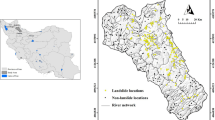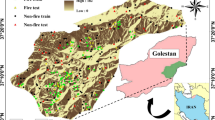Abstract
Rampant pasture burning has lead to various forest fires taking their toll over the health of many forests. Nanda Devi Biosphere Reserve, located in the northern part of India, witnessed a majority of these incidents in the recent past, though, it remains comprehensively untouched from research studies. The scale of these wildfires has led to an immense requirement of preventive measures to be taken for recuperating from such events. This requires for an in-depth analysis of the study area, its history of wildfires and their causes. These efforts would assist in laying a blueprint for a contingency plan in the event of a wildfire. This work proposes an evolutionary optimized gradient boosted decision trees for preparing wildfire susceptibility maps for the study area that would aid in the government’s forest preservation and disaster management activities. The study took 18 ignition factors of elevation, slope, aspect, plan curvature, topographic position index, topographic water index, normalized difference vegetation index, soil texture, temperature, rainfall, aridity index, potential evapotranspiration, relative humidity, wind speed, land cover and distance from roads, rivers and habitations into consideration. The study revealed that approximately 1432.025 km2 of area was very highly susceptible to forest fires while 1202.356 km2 was highly susceptible to forest fires. The proposed model was compared against various machine learning models such as random forest, neural networks and support vector machines, and it outperformed them by achieving an overall accuracy of 95.5%. The proposed model demonstrated good prospects for application in the field of hazard susceptibility mappings.









Similar content being viewed by others
References
Adab H, Kanniah KD, Solaimani K (2013) Modeling forest fire risk in the northeast of Iran using remote sensing and GIS techniques. Nat Hazards 65(3):1723–1743
Arpaci A, Malowerschnig B, Sass O, Vacik H (2014) Using multi variate data mining techniques for estimating fire susceptibility of Tyrolean forests. Appl Geogr 53:258–270
Batista AC (2000) Risk maps: an alternative for the planning of forest fire control. Floresta 30(1/2):45–54
Branke J (2012) Evolutionary optimization in dynamic environments, vol 3. Springer Science & Business Media, Berlin
Bui DT, Ho TC, Pradhan B, Pham BT, Nhu VH, Revhaug I (2016a) GIS-based modeling of rainfall-induced landslides using data mining-based functional trees classifier with AdaBoost, Bagging, and MultiBoost ensemble frameworks. Environ Earth Sci 75(14):1101
Bui DT, Le KTT, Nguyen VC, Le HD, Revhaug I (2016b) Tropical forest fire susceptibility mapping at the cat Ba national park area, hai phong city, vietnam, using GIS-Based kernel logistic regression. Remote Sens 8(4):347
Bui DT, Bui QT, Nguyen QP, Pradhan B, Nampak H, Trinh PT (2017) A hybrid artificial intelligence approach using GIS-based neural-fuzzy inference system and particle swarm optimization for forest fire susceptibility modeling at a tropical area. Agric For Meteorol 233:32–44
Chuvieco E (2003) Wildland fire danger: estimation and mapping: the role of remote sensing data, vol 4. World Scientific, Singapore
Chuvieco E, Cocero D, Riano D, Martin P, Martınez-Vega J, de la Riva J, Perez F (2004) Combining NDVI and surface temperature for the estimation of live fuel moisture content in forest fire danger rating. Remote Sens Environ 92(3):322–331
Conedera M, Torriani D, Neff C, Ricotta C, Bajocco S, Pezzatti GB (2011) Using Monte Carlo simulations to estimate relative fire ignition danger in a low-to-medium fire-prone region. For Ecol Manage 261(12):2179–2187
de Zea Bermudez P, Mendes J, Pereira JMC, Turkman KF, Vasconcelos MJP (2010) Spatial and temporal extremes of wildfire sizes in Portugal (1984–2004). Int J Wildland Fire 18(8):983–991
Ding C, Wang D, Ma X, Li H (2016) Predicting short-term subway ridership and prioritizing its influential factors using Gradient Boosting Decision Trees. Sustainability 8(11):1100
Earth Policy Institute, Wildfires by Region: Observations and Future Prospects (2017). http://www.earth-policy.org/images/uploads/graphs_tables/fire.htm, Accessed 20 Feb 2017
Eugenio FC, Dos Santos AR, Fiedler NC, Ribeiro GA, da Silva AG, Dos Santos ÁB, Schettino VR (2016) Applying GIS to develop a model for forest fire risk: a case study in Espírito Santo, Brazil. J Environ Manage 173:65–71
Ferraz SF, Vettorazzi CA (1998) Fire risk mapping in forests using a geographic information system (GIS). Scientia forestalis 53(1):39–48
Gao X, Fei X, Xie H (2011) Forest fire risk zone evaluation based on high spatial resolution RS image in Liangyungang Huaguo Mountain Scenic Spot. In: 2011 IEEE international conference on spatial data mining and geographical knowledge services (ICSDM), IEEE, pp 593–596
Ghinoi A, Chung CJ (2005) STARTER: a statistical GIS-based model for the prediction of snow avalanche susceptibility using terrain features—application to Alta Val Badia, Italian Dolomites. Geomorphology 66(1):305–325
Hargrove WW (1994) Using EMBYR, a large-scale probabilistic fire model, to re-create the Yellowstone Forest Lake fire. Environmental Research News, Oak Ridge National Laboratory: http://www.esd.ornl.gov/ernlembyr/embyr.html
International Strategy for Disaster Reduction, Forest Fires in India (2017). http://www.fire.uni-freiburg.de/photos/in/in.htm. Accessed 20 Feb 2017
Jaiswal RK, Mukherjee S, Raju KD, Saxena R (2002) Forest fire risk zone mapping from satellite imagery and GIS. Int J Appl Earth Obs Geoinf 4(1):1–10
Keane RE, Garner JL, Schmidt KM, Long DG, Menakis JP, Finney MA (1998) Development of input data layers for the FARSITE fire growth model for the Selway-Bitterroot Wilderness Complex, USA
Lentile LB, Smith FW, Shepperd WD (2006) Influence of topography and forest structure on patterns of mixed severity fire in ponderosa pine forests of the South Dakota Black Hills, USA. Int J Wildland Fire 15(4):557–566
Linn R, Reisner J, Colman JJ, Winterkamp J (2002) Studying wildfire behavior using FIRETEC. Int J Wildland Fire 11(4):233–246
Lombardo L, Cama M, Conoscenti C, Märker M, Rotigliano E (2015) Binary logistic regression versus stochastic gradient boosted decision trees in assessing landslide susceptibility for multiple-occurring landslide events: application to the 2009 storm event in Messina (Sicily, southern Italy). Nat Hazards 79(3):1621–1648
Lopes AMG, Cruz MG, Viegas DX (2002) Firestation—an integrated software system for the numerical simulation of fire spread on complex topography. Environ Model Softw 17(3):269–285
McGrattan KB, Baum HR, Rehm RG, Hamins A, Forney GP (2000) Fire dynamics simulator-technical reference guide. National Institute of Standards and Technology, Building and Fire Research Laboratory, Gaithersburg
National Aeronautics and Space Administration, Fire and Smoke, Forest Fire Numbers Rise in India in 2016 (2016). https://www.nasa.gov/image-feature/goddard/2016/forest-fire-numbers-rise-in-india-in-2016. Accessed 20 Feb 2017
Pastor E, Zarate L, Planas E, Arnaldos J (2003) Mathematical models and calculation systems for the study of wildland fire behaviour. Prog Energy Combust Sci 29(2):139–153
Pourghasemi HR (2016) GIS-based forest fire susceptibility mapping in Iran: a comparison between evidential belief function and binary logistic regression models. Scand J For Res 31(1):80–98
Sangal PM (1981) Suggested classification of forest fires in India by types and causes. In: Proceedings of the national seminar on forest fire control, held at Kulamavu during 1st to 4th November, 1981. [Trivandrum]: Govt. of Kerala, Kerala Forest Dept., 1981
Satir O, Berberoglu S, Donmez C (2016) Mapping regional forest fire probability using artificial neural network model in a Mediterranean forest ecosystem. Geomat Natural Hazards Risk 7(5):1645–1658
Sturtevant BR, Scheller RM, Miranda BR, Shinneman D, Syphard A (2009) Simulating dynamic and mixed-severity fire regimes: a process-based fire extension for LANDIS-II. Ecol Model 220(23):3380–3393
Suryabhagavan KV, Alemu M, Balakrishnan M (2016) GIS-based multi-criteria decision analysis for forest fire susceptibility mapping: a case study in Harenna forest, southwestern Ethiopia. Trop Ecol 57(1):33–43
The Indian Express, Understanding a burning issue for India’s forests (2016). http://indianexpress.com/article/explained/uttarakhand-fire-himachal-fire-india-forests-fire-2781274/. Accessed 20 Feb 2017
Van Wagner CE, Forest P (1987) Development and structure of the canadian forest fireweather index system. In: Canadian Forest Service Forestry Technical Report
Vilar L, Woolford DG, Martell DL, Martín MP (2010) A model for predicting human-caused wildfire occurrence in the region of Madrid, Spain. Int J Wildland Fire 19(3):325–337
Wildfire Today, Wildfire News and Opinion (2017) Why have fires gotten larger in recent decades? http://wildfiretoday.com/tag/statistics/. Accessed 20 Feb 2017
Wotton BM, Martell DL, Logan KA (2003) Climate change and people-caused forest fire occurrence in Ontario. Clim Change 60(3):275–295
Xue Y, Jiang J, Zhao B, Ma T (2017) A self-adaptive artificial bee colony algorithm based on global best for global optimization. Soft Comput. https://doi.org/10.1007/s00500-017-2547-1
Yang J, He HS, Shifley SR, Gustafson EJ (2007) Spatial patterns of modern period human-caused-fire occurrence in the Missouri Ozark Highlands. For Sci 53(1):1–15
Youssef AM, Pourghasemi HR, Pourtaghi ZS, Al-Katheeri MM (2016) Landslide susceptibility mapping using random forest, boosted regression tree, classification and regression tree, and general linear models and comparison of their performance at Wadi Tayyah Basin, Asir Region, Saudi Arabia. Landslides 13(5):839–856
Author information
Authors and Affiliations
Corresponding author
Rights and permissions
About this article
Cite this article
Sachdeva, S., Bhatia, T. & Verma, A.K. GIS-based evolutionary optimized Gradient Boosted Decision Trees for forest fire susceptibility mapping. Nat Hazards 92, 1399–1418 (2018). https://doi.org/10.1007/s11069-018-3256-5
Received:
Accepted:
Published:
Issue Date:
DOI: https://doi.org/10.1007/s11069-018-3256-5




